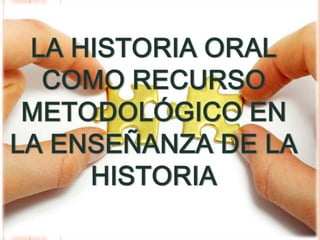
La historia oral como recurso para enseñar historia regional
- 1. LA HISTORIA ORAL COMO RECURSO METODOLÓGICO EN LA ENSEÑANZA DE LA HISTORIA
- 3. * Se debe responder a necesidades concretas de la comunidad escolar y la sociedad. *ESTA PROPUESTA pretende recrear y producir conocimiento histórico en relación con la familia, el barrio, ciudad y región.
- 4. *LA HISTORIA ORAL SON LAS MEMORIAS Y RECUERDOS DE LA GENTE VIVA SOBRE SU PASADO, PERMITIENDO AL EDUCANDO AMPLIAR SU CONOCIMIENTO DESPERTANDO SU ESPITIRU DE INVESTIGADOR. *Se acerca al docente y al alumnado a fuentes primarias de la propia historia REGIONAL.
- 5. PROPUESTAS METODOLÓGICAS : EL DESARROLLO DE LA ENTREVISTA . .
- 7. SEGÚN EL CASO, ESTA TENDRA LUGAR EN LA CASA DEL ENTREVISTADO O EN EL LUGAR DE TRABAJO. EN SU DOMICILIO PODRA CREAR UN AMBIENTE MAS FAVORABLE A LA CONVERSACION, EN UN ENTORNO RODEADO DE RECUERDOS, FOTOGRAFIAS SUSCEPTIBLES A AVIVAR LA MEMORIA. EN CONCLUSION NO EXISTE RECOMENDACIÓN DE UN LUGAR EN PARTICULAR, PERO CADA UNO CONDICIONA EL TESTIMONIO RECOGIDO.
- 8. NINGUNA ENTREVISTA DEBE REALIZARSE SIN UNA PREPARACION MINUCIOSA.
- 9. CONSULTA DE LIBRO RELATIVOS AL TEMA, A LA VIDA DEL TESTIMONIO, LECTURAS DE OBRAS ETC. A PARTIR DE LOS ELEMENTOS ESCOGIDOS SE REELABORARAN UNA GUIA DE PREGUNTAS QUE EL INFORMADOR DEBERA TENER PRESENTE DURANTE TODA LA ENTREVISTA, ESTA PUEDE SER DIRECTIVA, NO DIRECTIVA, SEMIDIRECTIVA,CADA UNA CON VENTAJAS Y DESVENTAJAS.
- 11. SUJETO VIVENCIA INTENCIONALIDAD CREACION DE CONCIENCIA
- 12. EL SUJETO QUE CONOCE LAS SITUACIONES DE SU ALREDEDOR SE FORMA PERCEPCIONES, IDEAS, VALORES, SIGNIFICADO, ES LA EXPERIANCIA VIVIDA QUE SE TRANFORMA EN UNHECHO DE CONCIENCIA COMPRENSIBLE; QUE PUEDEN SER SITUACIONES EN CONSTANTE MOVIMIENTO QUE DESLIZAN EN PRESENTE ACTUAL HACIA EL PASADO, FORMADO PARTE DEL RECUERDO A MANERA DE SIGNIFICADO. LA VIVENCIA Y LA INTENCIONALIDAD SON FUNDAMENTALES PARA ANALIZAR, CONOCER Y EXPLICAR EL CONTENIDO DE LAS EXPERIENCIAS, UNA ORIENTACION EN EL QUE EL SUJETO SE APROXIMA A LA REALIDAD. RETOMANDO LAS TRES VIVENCIAS DE LASMAESTRAS FLOR Y MARGARITA SOLO ACTUARON COMO RECEPTORAS, LA ENSEÑANZA DE LA HISTORIA FUE TRADICIONALISTA,SOLO SE ENFOCARON A LA MEMORIZACION, EN CAMBIO LA MAESTRA VIOLETA PERCIBIO LA ENSEÑANZA DE LA HISTORIA COMO ALGO MAS SIGNIFICATIVO, DESPERTANDO EN ELLA EL INTERES, Y EL GUSTO POR LA HISTORIA , PERMITIENDO CONSTRUIR SUS PROPIOS CONOCIMIENTOS Y VIVENCIAS.
- 13. * Las experiencias vividas no se olvidan del todo, parte de ese pasado permanece y está presente en la lectura actual del sujeto. *Los aportes de índole formativa que la historia proporciona a los sujetos : 1). La historia crea en los niños el amor por su país. 2).Les ayuda a pensar . 3). Aporta conocimientos de tipo metodológico y foemnta el espíritu crítico. *Los significados del pasado se construyen por el constante movimiento de nuevas experiencias .
- 14. TIEMPOS Y LUGARES EN LA HISTORIA . En el año 1786 durante el siglo XVIII surgieron las reformas borbónicas en la Nueva España. Mientras que en el mundo en el siglo XVIII era llamado “ El siglo de las luces “ siendo el último de los siglos de la edad moderna y el primero de la edad contemporánea internacional, dio lugar a notable desarrollo en las artes y la ciencia europeas de la mano de la ilustración , al mismo tiempo terminó el feudalismo y el vasallaje y se inicia la revolución industrial y el despegue económico de Europa.
- 16. DESARROLLO DE LA ENTREVISTA Personaje entrevistado: el negro Yanga. Nos encontramos en las faldas del Pico de Orizaba donde habita nuestro personaje entrevistado , quien vivió en la época de la Colonia el cual encabezó una rebelión en 1609 . 1.- ¿ Qué entiendes por La Colonia ?. R -= El tiempo en que estuvimos bajo el yugo español. 2.- ¿ Dónde sucedió este hecho ? R.= En un lugar desconocido para mi llamado La Nueva España. 3.- ¿ Cómo inició esta etapa en tu país ? R-= Con la llegada del enemigo, los españoles. 4.- ¿Quiénes participaron en las sublevaciones ? r.= Estuvimos indios y negros luchando por nuestra libertad- 5.-¿Cuándo inició esta etapa y cuánto duró ? R.= En 1521 hasta el año 1800, durando así 3 siglos. 6.-¿Qué consecuencias trajo la colonización a nuestro país ? R. Esclavitud, despojo de bienes, de religión, enfermedades, mestizaje, lenguaje, idiomas, actividades económicas, intercambio cultural.
- 17. 7.-.¿cual era la situación económica, política, social y cultural de nuestro país? R.= Todo era manejado por españoles peninsulares. 8.-¿Cómo finalizo este hecho? R.= con la sublevación de negros e indígenas y junto con ello la rebelión de los criollos por las ideas de igualdad, libertad y democracia